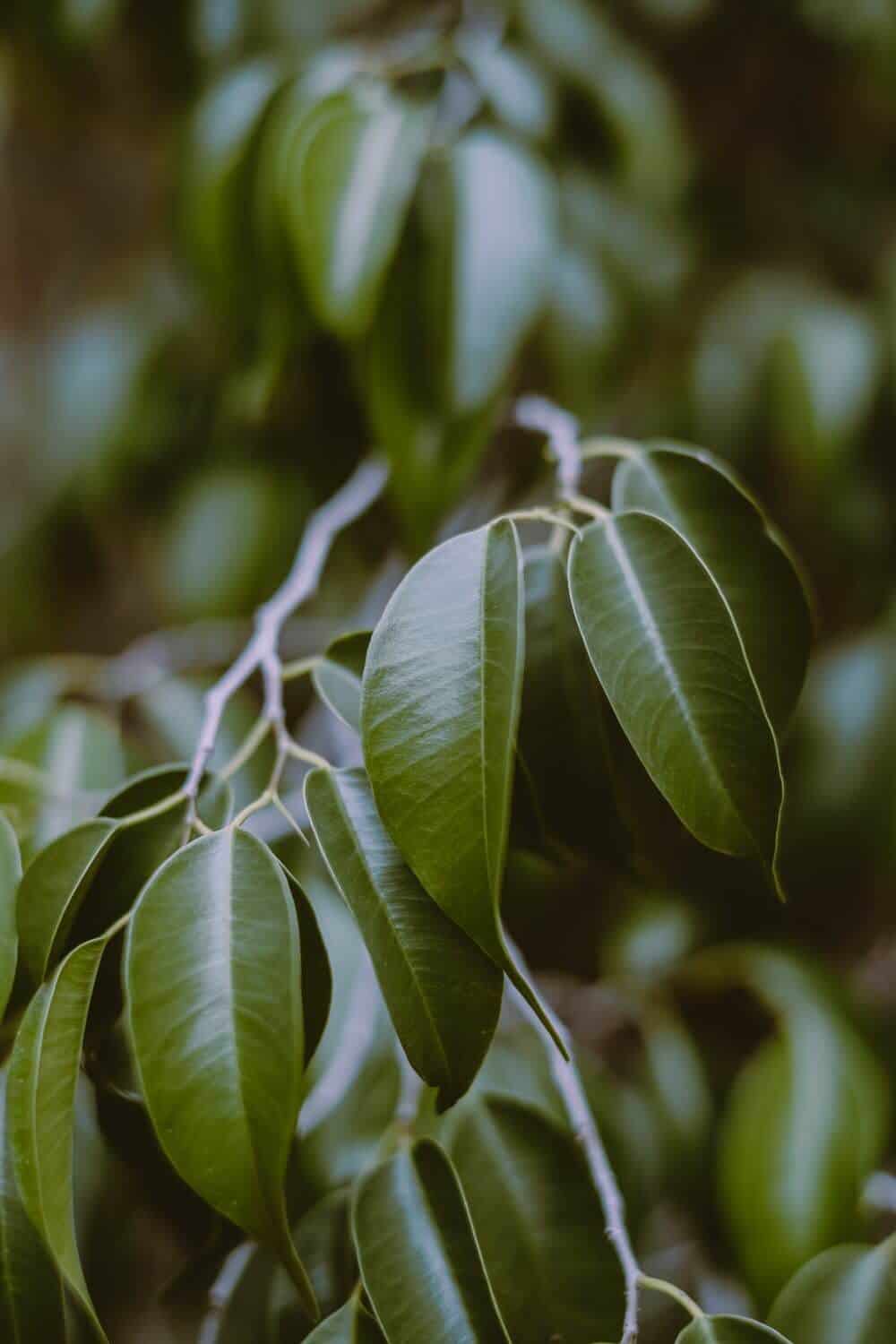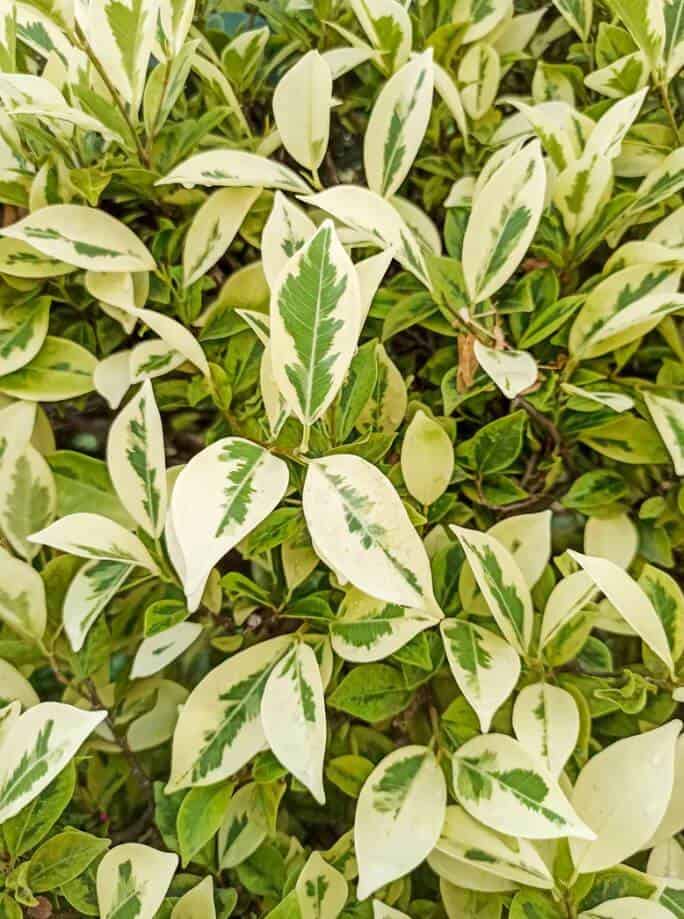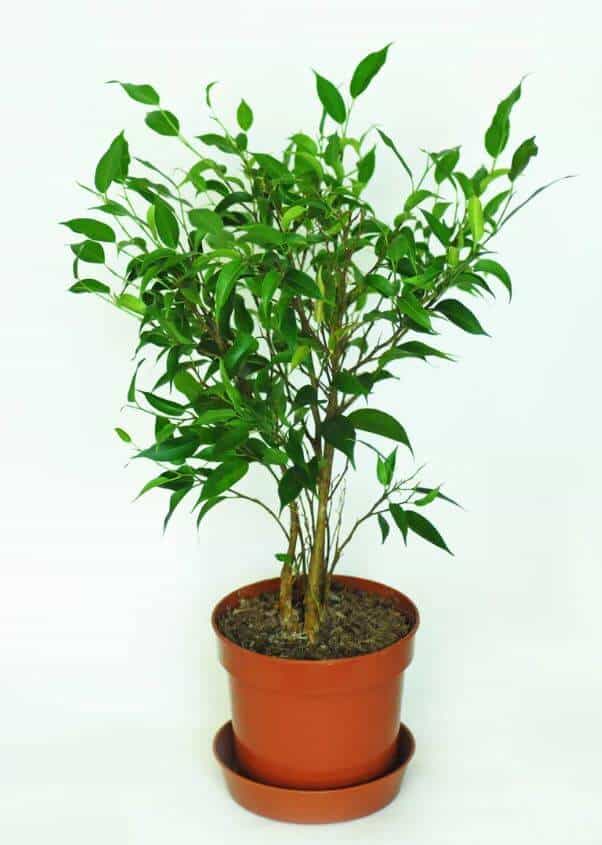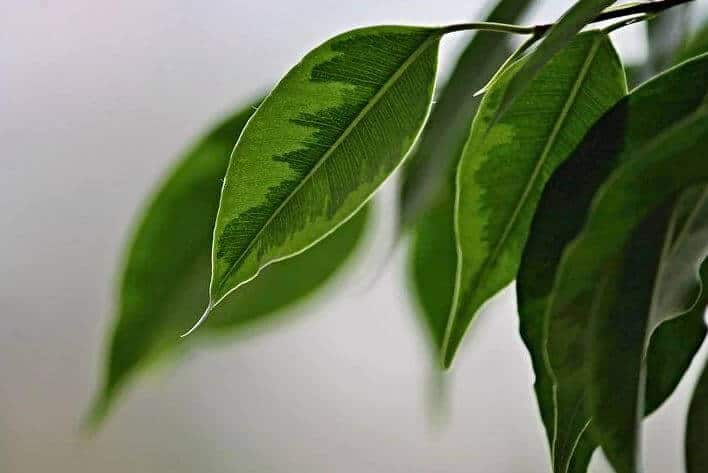Last Updated on January 10, 2023 by a Friendly Gardener
The Weeping Fig or Benjamin Fig is a Ficus tree generally cultivated as a houseplant. This evergreen perennial is classified as a broadleaf tree and finds its natural habitats in the tropics and subtropics of Australia and Asia. The Ficus Benjamina is a member of the Moraceae plant family. It is a rare tree in that it manages well in a low-light environment thus doing well in indoor lighting. Elegant arching branches are characteristic of this plant and fill with dark green foliage. Benjamin will shed its leaves if it is stressed.
Pruning will prevent plants from growing to unmanageable heights as the average indoor height usually measures from three feet to six feet and their trunks are braided for ornamental appeal. The Ficus Benjamin is a rapid grower. These trees can grow to an impressive sixty feet in height in their natural tropical or subtropical habitat. They are also often pruned to use as hedges.
This tree was featured in NASA’s study on various plants’ abilities to remove toxins from environmental air. The Benjamin earned high removal ratings for benzene, formaldehyde, and trichloroethylene.
The Moraceae family is a group of woody plants with more or less 850 various species. Ficus root systems when cultivated outdoors are known to be invasive thus creating problems for driveways, sidewalks, and patios. It is considered in various states to be too large for residential landscaping and is limited to hedge functions.
Ficus Tree Plant Care

The Ficus tree does very well when cultivated indoors. It needs a position that ideally offers bright indirect sunlight or can be placed in a sunny area offering partial shade. Watering should be done on a regular schedule during the plant’s growing season, and then reduced in colder months.
When your last frost has passed, you can move your Ficus outside for the warmer season. They will, however, need to be returned inside when the weather changes. The Ficus manifests its distress through leaf dropping. So this behavior can be attributed to a variety of causes among which we find pest infestation. The Ficus Benjamin is a creature of habit so to speak and does not enjoy being moved around from one location to another.
Soil
Fast-draining high-quality potting soil is perfect for cultivating your Ficus. The Ficus does not really require organically rich soil. Soil pH is best when measuring between 6.0 and 6.5, especially for weeping figs and rubber trees. With a lower pH, the soil will have too much acidity for your Ficus, causing it to decline. Containers require an adequate number of drainage holes.
Any type of soil that maintains the correct acidity will work as long as drainage is guaranteed. Loamy soil beds are fine. Clay-based soils tend to retain too much water especially outdoors risking root rot. A predominantly sandy soil bed will guarantee drainage but will need more frequent watering because it lacks adequate moisture retention.
Light
The Ficus tree needs bright indirect light. They will tolerate a limited amount of exposure to direct sunlight during morning hours. Its natural tropical habitat is naturally shady, but even so when cultivated inside, the Ficus must have access to light. Remember that your Ficus does not appreciate being moved so find a well-lighted permanent spot.
Water and Humidity
Moist soil that is not soggy or water-logged is the basis for successful Ficus cultivation. Any Ficus left sitting in soggy soil or too much water will drop its leaves in protest and eventually root rot will set in. Your plant’s watering schedule should be regular as this plant is sensitive to moisture changes. At the beginning of the dry season in their natural habitat, they do normally drop foliage.
The Ficus thrives in high humidity. Dry environments will cause them to lose leaves. A space humidifier can help raise indoor humidity levels if your climate is arid. Good misting of the tree’s foliage and a moist soil bed will help your Ficus avoid drying out.
Temperature
An optimal temperature for the Ficus will measure between 75° and 85° Fahrenheit during the day and between 65 and 70° F at night. In the summer avoid using strong air conditioning in the event that your indoor temperature falls below 70°F. The Ficus tree is sensitive to cold and drafts.
Feeding

The Ficus Benjamina is a heavy feeder that loves to eat so generous fertilizing is a must during its growing season. Because this plant grows rapidly it needs to be fed at least once monthly in the spring and summer seasons. Feeding can be reduced bimonthly in the fall and winter. If your Benjamin loses foliage when the temperature, lighting, feeding, and humidity, are optimal, it might need magnesium and manganese supplements.
Pruning
Prune your Ficus tree if it grows to the ceiling and perhaps touches it. You can also shape your Ficus tree’s growth to a desirable form. Always prune the plant when it is not growing but is dormant. There is less risk of injury from pruning while the plant is in dormancy.
Trim and remove dead branches. Also, remove spent or dead foliage to prevent fungal infections year-round.
Repotting

A ficus tree needs to be repotted annually because it is a rapid grower.
Toxicity and Pets
A Ficus Tree is toxic to cats and dogs as well as horses but is not toxic to humans. It will be a problem for people with latex allergies. The weeping Fig does contain latex, hence it is not advised to position it where those with latex allergies will be.
Clinical signs of Ficus poisoning in pets that are common include dermal irritation and gastrointestinal distress. When a pet ingests Ficus Benjamina, get in touch with your veterinarian immediately.
Pests, Diseases, and Problems
Scale is the most often found in Peston the Ficus. It appears as a waxy mass or bumps stuck on a leaf or stem. You should scrape off the scale with your fingernail or treat your plant with insecticidal soap or organic Neem oil. Aphids are also common and can likewise be treated with insecticidal soap. More than one treatment will most likely be necessary.
Ficus trees normally shed foliage. In the event that your plant sheds a large number of leaves, it may be stressed. Check to see if the plant has been moved from its preferred location, recently repotted, has sufficient access to light, or is the victim of incorrect watering. By investigating, you can usually arrive at the cause and correct it.
Ficus Propagation

You can easily propagate your Ficus tree with stem cuttings. The spring is the best moment to take your cutting. Seed is generally not used to propagate the Ficus. When raised indoors it rarely produces either fruit or seeds.
Steps for propagation:
- Cut a three-to-five-inch stem cutting with a minimum of two sets of leaves. The stem cutting should be trimmed from the tip of a healthy branch. Snip the branch roughly ¼ inch underneath a set of leaves. Remove any foliage from the cutting’s lower half and treat the cut end with rooting hormone.
- Put cutting into a pot of moistened peat moss, with the cut end in the soil. Cover the pot and cut with plastic. Plastic should not touch the cutting. Bind your plastic sheet or bag around the pot’s bottom.
- The pot should be positioned in a location with bright indirect sunlight and the temperature should measure above 65°F. Mist your cutting daily and keep the soil moist.
- Roots should develop in two to four weeks. Cut the plastic open to aid your new plant in adjusting to its new environment.
- Transplant the new plant at six weeks into a container about six inches in diameter and enjoy
The Final Word
The Ficus tree will grow more slowly than when it is cultivated outdoors, but with proper care and a little TLC, your Ficus can live for years and will be an appreciated fixture in any home or office décor.

